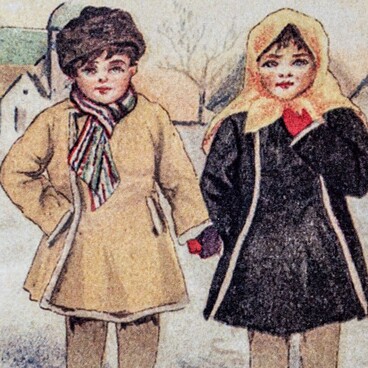The foreground of the postcard shows a group of four children of different ages playing near the porch of a peasant house. Children are dressed only in shirts of different colors: white, red, blue, gray. The walls of the house are white, with shingles (a material for construction) visible in some places. The porch is wooden. There is a white church with two greenish domes, a gate leading to the churchyard and part of the fence in the background. The church is surrounded by all trees.
There is a horizontally located facsimile of the artist’s monogram in the lower right corner of the picture: “OA 1902.” There is an unpainted strip 1.2 centimeters wide along the lower edge of the front side. On the back, address side, inscriptions and lines are arranged horizontally; there is no vertical dividing line. The top margin contains typographic black text on two lines: “World Postal Union. Russia. Union Postale Universelle. Russie.” Below it, there is an inscription in large black letters: “Open letter - Carte postale.” On the bottom margin in typographic font, in small italics: “Only the address can be written on this side.” There are four thin lines of hints for writing the address along the main field.
In the upper left corner there is a stamp of the Charity Society at the St. Petersburg obstetric institution in green color: there is a double circle under the large imperial crown, which is covered with a figured shield in a lower part. Inscription in the circle: “In favour of the Ch. Soc.at the SPb obst. inst.” A horizontal inscription in five lines is placed along the central print margin: “Under the patronage of Her Imperial Highness Grand Duchess Olga Aleksandrovna.” There is an abbreviation on the shield, in decorative large print: “VUIM.” No stamp was required.
The World Postal Union was organized on September 15, 1874 by twenty-two European countries, including Russia. Participants gathered in Bern for the First General Postal Conference. There the countries signed the World Postal Treaty, which entered into force on July 1, 1875. The treaty declared all the adjoining states to be a “single postal territory” with uniform tariffs for sending international mail. The gold franc was taken as the basis for the conversion of currencies.
There is a horizontally located facsimile of the artist’s monogram in the lower right corner of the picture: “OA 1902.” There is an unpainted strip 1.2 centimeters wide along the lower edge of the front side. On the back, address side, inscriptions and lines are arranged horizontally; there is no vertical dividing line. The top margin contains typographic black text on two lines: “World Postal Union. Russia. Union Postale Universelle. Russie.” Below it, there is an inscription in large black letters: “Open letter - Carte postale.” On the bottom margin in typographic font, in small italics: “Only the address can be written on this side.” There are four thin lines of hints for writing the address along the main field.
In the upper left corner there is a stamp of the Charity Society at the St. Petersburg obstetric institution in green color: there is a double circle under the large imperial crown, which is covered with a figured shield in a lower part. Inscription in the circle: “In favour of the Ch. Soc.at the SPb obst. inst.” A horizontal inscription in five lines is placed along the central print margin: “Under the patronage of Her Imperial Highness Grand Duchess Olga Aleksandrovna.” There is an abbreviation on the shield, in decorative large print: “VUIM.” No stamp was required.
The World Postal Union was organized on September 15, 1874 by twenty-two European countries, including Russia. Participants gathered in Bern for the First General Postal Conference. There the countries signed the World Postal Treaty, which entered into force on July 1, 1875. The treaty declared all the adjoining states to be a “single postal territory” with uniform tariffs for sending international mail. The gold franc was taken as the basis for the conversion of currencies.






